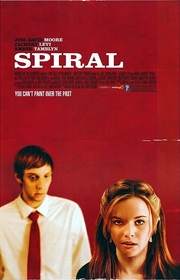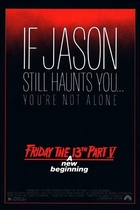Our editor-in-chief Nate Yapp is proud to have contributed to the new book Hidden Horror: A Celebration of 101 Underrated and Overlooked Fright Flicks, edited by Aaron Christensen. Another contributors include Anthony Timpone, B.J. Colangelo, Dave Alexander, Classic-Horror.com's own Robert C. Ring and John W. Bowen. Pick up a copy today from Amazon.com!
Spiral (2007)
PG-13 horror films can be tricky affairs. They must walk a fine line, trying to be frightening and suspenseful without being too horrific or graphic. When not done well, they can seem bland, silly, or both. However, when done properly, the right director can take the MPAA-mandated limitations and turn them into strengths. Spiral, from directors Adam Green (Hatchet) and Joel David Moore (who also co-wrote the screenplay and stars), is an example of the latter. This film doesn’t rely on shocks or graphic violence. Instead, it takes time to explore its main characters and pulls us in to a story that is both suspenseful and intriguing.
Mason (Moore) is a quiet, introspective young man doing phone work for an insurance company, painting vivid portraits of women in his spare time. His only friend appears to be his boss Berkeley (Zachary Levi), who is sometimes more of an older brother. One day at work, Mason meets a new employee named Amber (Amber Tamblyn), and they quickly become attracted to each other. Within Mason, however, lurks a violent history with relationships, and Amber must discover his secret to avoid being his next victim.
This is a very stylish film. Its atmosphere exudes despair and oppression. It is often raining, and even in the scenes where it is not raining, it has the feel of an overcast day. We never see a bright sunny day. This lends an air of depression and hopelessness to the film (in a similar fashion as Se7en), and it is a visual reminder of Mason’s character, who seems depressed and hopeless himself. Mason’s apartment offers a similar feeling. On the surface it looks like a Bohemian artist’s loft, but it is dank and depressing and, in an effective technique, the inside of the bathroom is never shown. We only ever see Mason looking at the bathroom door, which seems to have a bright light shining within it. Mason always looks at it with terror, which makes us wonder what went on in there. Complementing the dreariness of Mason’s home, the film has the world of a call center down perfectly, with its identical cubicles, cliques, and stifling anonymity presented very well. This oppressive world only serves to isolate Mason more, and reinforces to us how insignificant he feels.
The film’s score, almost exclusively jazz compositions, provides a contrast to the rest of the atmosphere. Since Mason loves it so passionately, it serves to show us that it is his only escape from this deadening world. It also makes for a refreshing contrast to the many films that use pop songs as their sound track. Overall, the film generates an atmosphere of hopelessness and fear, which greatly enhances am already suspenseful script. It is one of the film’s best assets.
The directors also make good use of their camera work to visually enhance the film’s story. There are many two shots in this film, often with Mason and either Berkeley or Amber. The significance of these shots is not completely apparent until the end of the film, but this is purposely done. The two shots show us that Mason needs another person to make him function in society, but also that one person at a time is about all he can deal with. Another technique is having Mason often wake up screaming from a nightmare. As the film progresses, we begin to wonder if Mason is just having bad nightmares or if he is just reacting to horrific things that he has done. It makes sure that we know Mason has severe problems that can’t be easily conquered. The directors also show Mason several times looking to his left with ominous dread at the bathroom door. This technique, coupled with Mason’s sheer terror when he looks at the door, is very effective in inspiring apprehension and curiosity in the audience.
The main two cast members of the film serve it well. Joel David Moore is outstanding as the troubled Mason. In some ways, he is like a serious, disturbed Napoleon Dynamite. He does not have humorous put downs or silly phrases, but he is very quiet, and often has the blank looks of Jon Heder’s comic creation. In Moore’s hands, however, these characteristics are not amusing, but are instead sad and frightening. He is an extremely introverted person who constantly has to take puffs from an inhaler, and who is so quiet that a single pound on a table from him can be quite frightening. Talking and moving slowly, as if he is afraid to attract any attention to himself, Mason is at the same time a character that prefers to remain in the background and is also yearning for human contact. His quietness and apparent gentleness allows us to be genuinely unsettled near the end when he becomes violent.
Tamblyn is also good as Amber. She plays the character as a complete contrast to Mason (contrast is a word heard often throughout this film). She is outgoing, funny, and willing to experiment with new ideas, such as being a portrait model. However, she is not merely a buddy for Mason. In one scene, when she startles Mason and causes him to have a breathing fit, she is extremely sad and sorry, and she feels terrible that she even accidentally hurt Mason. Tamblyn plays Amber as almost exactly what Mason needs (until her curiosity gets the best of her at least). Her performance is the equal of Moore’s.
Probably the best aspect of Spiral is its script. It contains a very unexpected twist at the end, so if you haven’t seen the film, it might be best to stop reading here. There are some minor weaknesses (like the sketchiness of the relationship between Mason and Berkeley), but overall the film has a very clever plot, one that is suspenseful and even Hitchcockian. Throughout the whole story, it is apparent that Mason has an obsessive concern with his paintings and his “rules.” Near the end, Amber discovers that Mason has known many women and has done almost identical paintings of them. However, when she breaks Mason’s rule that she never looks at his sketches until the paintings are complete, he breaks down, and violently kills her. The next day, Berkeley tells Mason (and us) that these women and their murders are figments of Mason’s imagination. However, we then find out that Amber was actually real, as opposed to the earlier imaginary women, and that Mason, unable to tell the difference, had actually committed murder. It is a satisfactory and unexpected twist.
Spiral has more than a few similarities to the films of Alfred Hitchcock. Mason’s desire to remake Amber into the image of his imaginary women echoes the latter sections of Vertigo, and Mason’s idea that he is a killer when actually his father was a killer (another weakness of the script is that it doesn’t explain more about this) has some echoes of Psycho. The double twist ending also feels like an idea that would have appealed to Hitchcock. The script is not as tightly woven as one as Hitchcock would have used, and the film does not have the extended suspense of a Vertigo or a North by Northwest, but it is clever and very satisfying.
This is not a perfect film. One of its flaws is the character of Berkeley. As Berkeley, Zachary Levi does a satisfactory job. His function in the story is basically to care for Mason and spout fairly clever one-liners. He does both of these things well, and he is believable in the role, but he does little more than that. It is difficult to tell if this is the problem of Levi, or the writing of the character, but Berkeley is a fairly thin character. If we had more information about the past history of these two characters, it might have been easier to evaluate Levi’s performance. As it stands, it is an adequate performs its function to the story and not much else. Also, the film at times relies on flashy, sudden and brief appearances of Diana (Annie Neal), a woman that Mason may or may have not killed in the past. These images don’t inspire fear or tension, and actually detract from the careful suspense of the rest of the film. They feel gimmicky and cheesy, which the rest of the film is most definitely not.
Spiral is a good, suspenseful film. It is not actually “scary,” but it is intriguing and well made. The smart script and taut direction, complemented by a solid cast, give us a film that is tense and entertaining. It is proof that a PG-13 horror film can be good if it is done properly and thoughtfully.









your blog is very helpful and
your blog is very helpful and i wanna thank you for all the work you are doing in the horror movies section and i have a little favour to ask you
i wish you dont find it diffcult 'cause i did and i kept trying for a month to find it's name but without any result
you know this movie has a jazz soundtrack but in the end of the movie when mason visited his mother in the cemetry. there was a nice music i wish you can tell me it's name and it wasn't a jazz music at all
and thanks again for your effort
I was flipping thru the
I was flipping thru the channels and Spiral was just beginning. Every second that I watched and listened to the soundtrack made me anxious to know where in Mason's life was I being lead to next.
I couldn't stop watching. I didn't WANT to stop watching. I didn't want to stop watching when it ended!!
I'm going shopping for the DVD and soundtrack CD today!
Who is the artist and what is the name of the song when Mason was at the cemetary?
~M~
hey i look to for the song,
hey i look to for the song, here is it:
sometimes alex lloyd
http://www.youtube.com/watch?v=n-HNWOQmFZM
peace dude